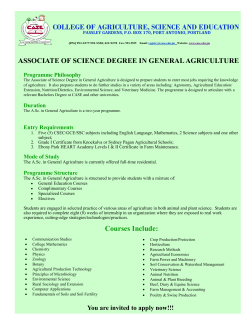
Components and Conceptual Framework in agricultural policy
Components and Conceptual Framework in agricultural policy Contents 2.1. Components of a Policy Framework ............................................................................................. 1 2.2. Conceptual frameworks in agricultural policy processes ............................................................. 2 2.1. Components of a Policy Framework The four central components in the framework for agricultural policy analysis are objectives, constraints, policies, and strategies. Objectives are the desired goals of economic policy as defined by the policy makers. Government officials wish to achieve certain ends when they intervene in economies. Constraints are the economic realities that limit what can be accomplished. If land is used to grow rice, it is not available to produce an alternative crop in that production season. Policies are the instruments that governments can use to change economic outcomes. Effective policies change the behavior of producers, marketers, and consumers and create new economic outcomes. Strategies are the sets of policy instruments that government officials can use to achieve their objectives. Each strategy is enacted through the introduction of a coordinated set of policies. The policy framework, portrayed in Figure 2.1, is represented by a circular (clockwise) set of causal linkages among the four components. The strategies of policy makers consist of sets of policies that are intended to improve economic outcomes (as judged by the policy makers). The selected policies work through the constraints set by economic parameters. The constraints set by supply, demand, and world price conditions, either further or impede the attainment of objectives. An assessment of the impact on objectives permits an evaluation of the appropriateness of given strategies. Governments thus form agricultural strategies by choosing a set of policies to further their objectives subject to the constraints 1 on the agricultural economy. With this logical picture in mind, it is important to review each of the four components in more detail. Figure 2.1. Graphic Representation of a Policy Framework 2.2. Conceptual frameworks in agricultural policy processes This section briefly describes three main conceptual public policy frameworks often used in analysis: The rational model, the networking approach, and the policy triangle framework. 1. The stages or rational model In this model, the public policy process is divided into four stages: Agendasetting, formulation, implementation, and evaluation. In the agenda-setting phase, policymakers compare and calculate the political, social, and economic costs and benefits of alternative public policy options and then select the best option. In the formulation stage, legislatures and other decision making bodies design and enact policies. Prior to the implementation stage, experts collect 2 and analyze data to provide policymakers with the best policy option among a range of alternatives. At the implementation phase, policymakers assess the potential impact of a given policy. The rational model of the public policy process represents a linear approach which can be easily adopted for agricultural policy process. 2. The bargaining or network approach Policy process involves negotiation, bargaining, and the accommodation of diverging interests. These, in turn lead to the formulation and implementation of policies. In this framework, there are uncertainties that face policymaker. These are substantive uncertainty and procedural uncertainty. Substantive uncertainty is about the lack of relevant information about events while procedural uncertainty is related to the gaps in problem solving capacities. These uncertainties lead to policymaking that is inherently incremental and rulebased policymaking, which tends toward avoiding costly policy innovations or significant departures from routine practices. 3. The policy triangle framework The framework considers how all the four elements (policy content, actors, context, and processes) interact to shape policy. it can be visually depicted as a triangle with content, context, and processes at the three corners and actors situated in the center. The triangle is a simple three-sided shape that is used in this framework to provide an engaging entry point into the complex interrelations that exist among the four factors described earlier. Policy formulation falls into the triangle’s “process” corner. This corner, however, is continually influenced by actors, content, and context. 3 It is a process of negotiation that varies according to the policy-enabling environment and the organizational structure (actors, content, and context) in which the policy is being made and the nature or content of the policy in question. This process includes the gathering of information, various discussions and debates, the development of policy alternatives, and so on. Figure 1 demonstrates how the policy triangle framework can be modified to illustrate the institutionalization of policy coherence in agriculture. Organizational structures have replaced actors at the center of the triangles. The three corners have been relabeled, “enabling environment/content”, “actors”, and “resources.” The complex interrelations among these factors are continually influenced by organizational structures (such as the FMAWR), capacity levels, degrees of knowledge management, and flows of communication and information. 4
© Copyright 2025












